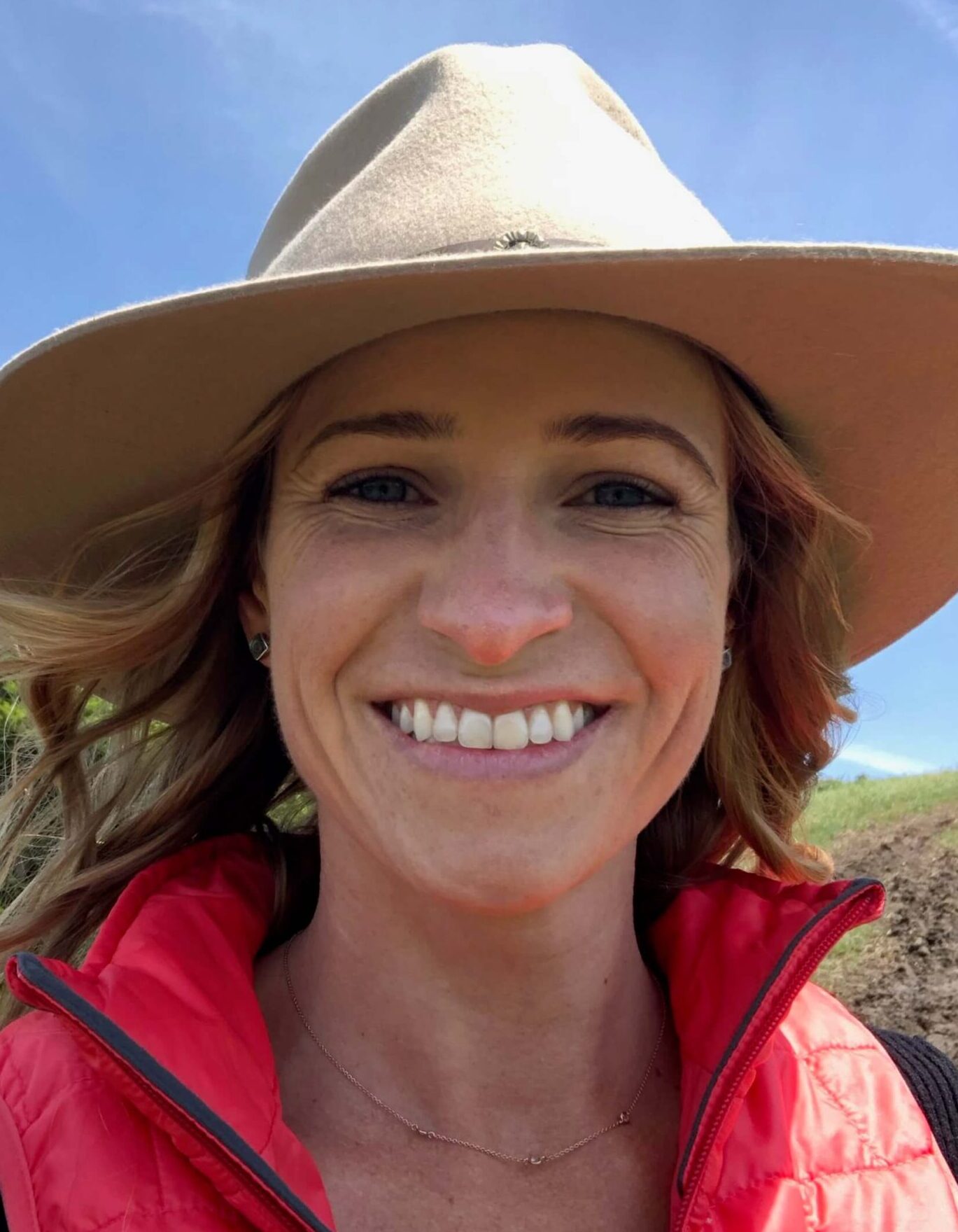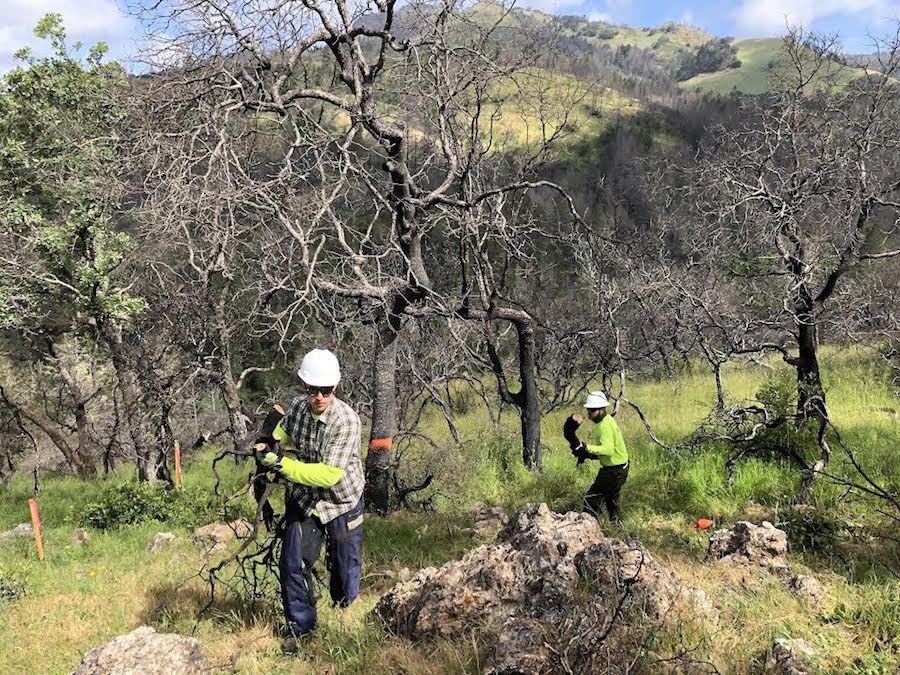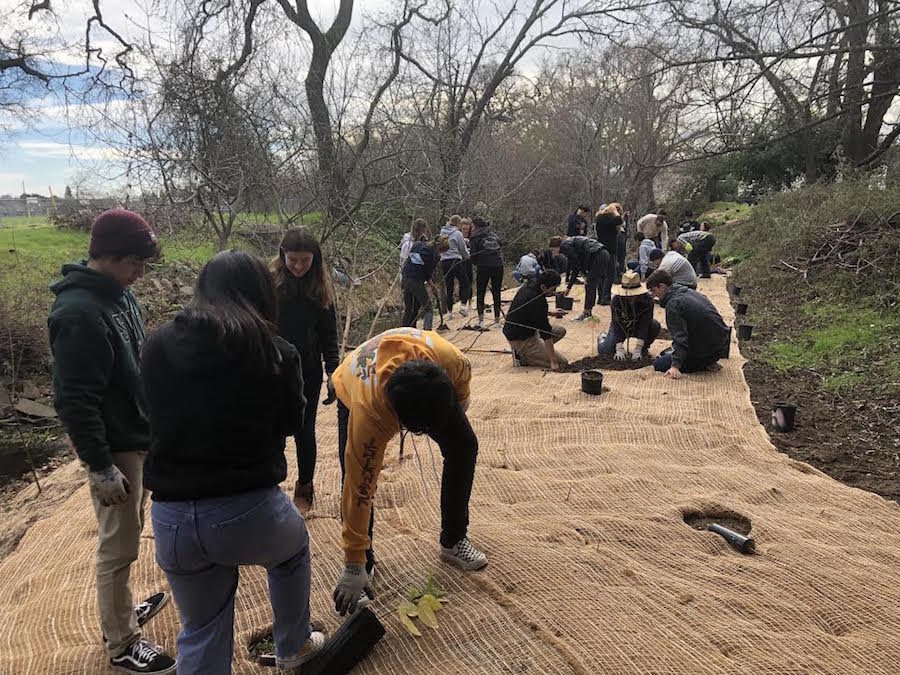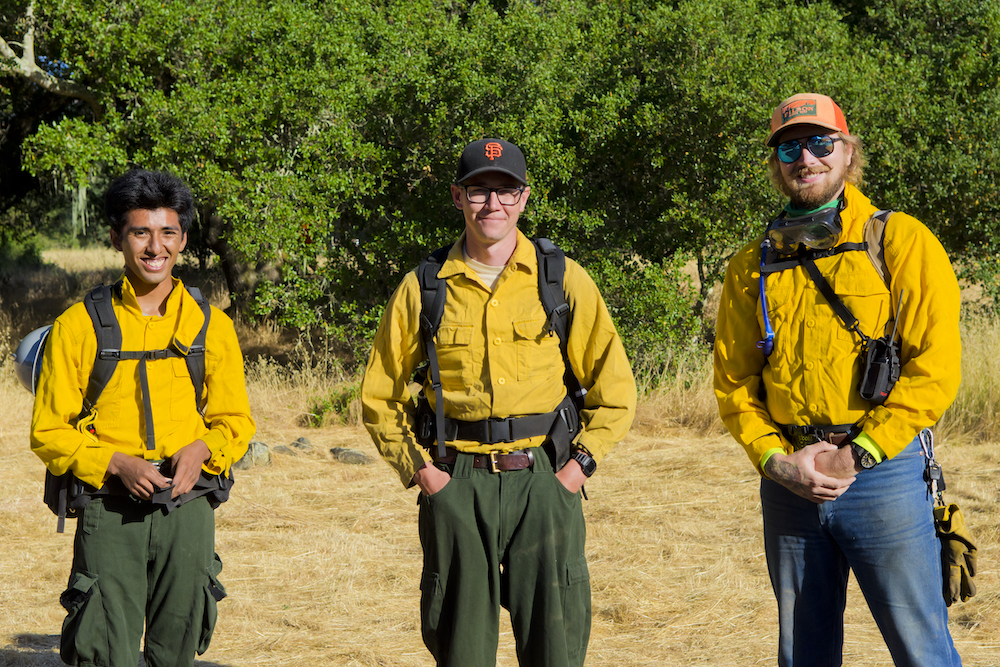Habitat Restoration & Land Management
Sonoma Ecology Center’s Restoration Department is dedicated to the restoration, stewardship and enhancement of over 4,000 acres of private and public lands around Sonoma Valley. Those include Sugarloaf Ridge State Park, Sonoma Garden Park, Sonoma Creek, Nathanson Creek, the Montini and Sonoma Overlook Trail Preserves, and Van Hoosear Wildflower Preserve. Throughout Sonoma Valley and beyond, our trained professionals provide ecological restoration services including: biological site assessments, native plant seed collection and propagation, invasive plant mapping and treatments, stream bank stabilization and erosion control, and fire fuel management.
Our Restoration Team is working on public and private sites throughout Sonoma Valley and the surrounding regions of Northern California.
To contact us about projects or to request our services, please email restoration@sonomaecologycenter.org or call 707-996-0712 ext. 116.
Our Restoration Department has more than 25 years of successful experience performing natural resource management projects to the satisfaction of public and private clients.
We know how to plan for and accomplish management goals in sensitive habitats with effective, high-quality and affordable methods. Our depth of experience assures quality control on work we carry out, and allows us to incorporate adaptive management techniques that ensure project goals are met in a timely and efficient manner. We utilize smaller crews with technical expertise to maximize budgets and get projects done to a high level of quality.
Our service area focuses on Sonoma Valley and extends to the surrounding regions of Northern California. We have experience working in many of northern California’s natural habitats, including dunes, coastal scrub, grasslands, chaparral, oak woodlands, mixed evergreen forest, redwood forest, wetlands and riparian ecosystems. Our project team has the ecological knowledge, as well as specialized equipment and capacity, to carry out all of the requested services.
Capabilities & Services
- Full service fish and wildlife habitat restoration for landowners (weed control, erosion control, bank stabilization, native plant installation, irrigation, maintenance)
- Native plant restoration
- Invasive non-native weed eradication: French broom, Himalayan blackberry, vinca, and English ivy.
- Native plant production – specializing in local/ watershed-sourced genotypes (seed collection/storage, propagation, growing/transplanting)
- Fish Barrier removal
- Stormwater management/low impact design (Erosion control, sediment filtration, etc.)
- Storm drain retrofitting (energy dissipater, detention basin, geotextile fabric installation).
- Bioengineering (willow revetments, willow mattresses, vegetated swales, etc)
- Erosion control (plants, geotextile, biodegradable fabric/ wattles, etc.)
- Land management (full service – Habitat restoration and management)
- Flood Management
- Biochar Demonstrations and Biochar Kiln Burns
Project Sites
Sonoma Creek
Sonoma Creek is one of the most important streams in the Bay Area due to the habitat it provides for native fish and wildlife. For two decades, Sonoma Ecology Center’s Restoration Department has serviced and improved Sonoma Creek by removing barriers to native fish migration, improving fish habitat, keeping stream banks and beds from washing away, slowing and filtering stormwater, invasive plant control, and planting native plants. We work constantly with creekside landowners and in partnership with Sonoma Water, the Wildlife Conservation Board, the California Coastal Conservancy and Environmental Science Associates to further the stewardship of Sonoma Creek.
Montini Open Space Preserve and Sonoma Overlook Trail
In collaboration with the City of Sonoma, Sonoma Ecology Center is responsible for the management and maintenance of both of these cherished open space preserves, located on the city’s northern border. Our trained Restoration professionals conduct trail work, hazardous tree assessment, invasive plant control, and habitat restoration at both preserves, and help mitigate fire danger at Montini through invasive weed management, targeted mowing and by hiring grazing subcontractors. Restoration crew members also guide volunteers in planting, weeding and other volunteer events at the preserves. More on Montini / More on Overlook
Nathanson Creek Preserve
Working with the community, Sonoma Ecology Center designed and built this three-quarter-mile preserve with the support of $2 million in grant funding thanks to partnerships with the Sonoma County Agricultural and Open Space District, Sonoma Water, the U.S. Fish and Wildlife Service, and the City of Sonoma. This formerly neglected site now provides the community with clean recreational space, walking paths, signage, a Native Plant Demonstration Garden, a demonstration floodplain, and outdoor educational opportunities for three neighboring schools. It is also drawing native wildlife, including steelhead, back into its riparian habitat. Our Restoration staff continues to steward Nathanson Creek through management of invasive species, restoring habitats with native riparian plants, and managing stormwater debris and erosion control. More on Nathanson
Van Hoosear Wildflower Preserve
Our biologists and restoration ecologists have developed management plans for this 163-acre preserve, mapping natural resources as well as locations of sensitive and threatened species. As a result, threatened species are being protected while invasive species are managed and removed, helping return the preserve (which is protected under a conservation easement) to its original pristine state. Sonoma Ecology Center’s Restoration Department is a key component of these ongoing conservation practices. More on Van Hoosear.
Project Details
Native Plant Propagation
Native plants are key to a healthy ecosystem: they support and sustain native fish and wildlife, stabilize creek banks, and—because they are adapted to native soils—they have more efficient water uptake and can improve water infiltration for groundwater. Over the last five years, SEC has grown and planted over 25,000 native plants. Read more about native plants and our Native Plant Nursery.
Invasive Weed Removal
After human development, invasive species are the second greatest cause of habitat loss in the world. In addition to displacing native plants and animals, invasives can increase fire risk and harbor pests. SEC staff created the model for eradication of Arundo (a highly invasive weed in Western streams) in California. The SEC Restoration Crew also specializes in the removal of French broom, Himalayan blackberry, vinca, and English ivy in addition to Arundo.
Restoration Staff

Lauren Claussen
Restoration Program Manager
Lauren graduated from UC Berkeley with a degree in Molecular Environmental Biology, and later attended Oregon State to obtain an MS in Natural Resource Management. She began her career working in marine biology at Scripps Institute of Oceanography, then fell in love with the north coast and moved to Sonoma County. Prior to joining Sonoma Ecology Center, she worked in viticulture and land management throughout Sonoma and Napa counties, and incorporated ecological improvements wherever possible! This experience working in our local agricultural community cemented her desire to collaborate with and help educate local landowners on beneficial ecological practices. Outside of work, she can be found gardening, hiking with her dogs, and biking all over Northern California. She holds a qualified applicator license with the Department of Pesticide Regulation (QAL #137282).

Manuel Hernandez
Restoration Project Manager
ISA Certified Arborist ® WE-14183A
Firefighter 2
Mr. Hernandez joined SEC in March 2022. He earned a BS in Biology from Sonoma State University while working for Sonoma State’s Center for Environmental Inquiry as a trail steward and docent at Fairfield Osborn Preserve. He earned an M.S. in Biology from Sonoma State in 2020 studying the effects of sudden oak death on the fire severity of the 2017 Nuns Fire. Before coming to SEC he was a Part-time crew leader at Circuit Rider Community Services’ Ecological Program.

Eric Schoohs
Land Management Planner
Eric grew up on a farm in small-town Wisconsin before graduating from the University of Wisconsin with a BS in Biology and Environmental Studies. He made his way to Seattle where he got his first peek into the conservation world through an AmeriCorps program, and never turned back. Whether under titles like Naturalist Guide, Stewardship Lead, or ‘that guy,’ Eric’s passions for connecting people to the land and each other, conducting prescribed burns, and leaving healthy landscapes for future generations, keep him motivated and engaged. Outside the office you can find him reading, surfing, or channeling his undying curiosity for the natural world.

Robert Symens-Bucher
Restoration Technician
Robert was born and raised in Oakland, CA. As a child, he loved getting out of the city to go hiking, camping, and backpacking in California’s wild places. As an adult, he has had the privilege to return to many of the same places in the capacity of a naturalist and restoration technician. He attended college at UC Berkeley, where he graduated with a BA in Geography and was galvanized towards a career in environmental restoration. His interests lie at the intersection of human land use and Nature, and his passion is to create a world where the two not only coexist, but thrive together in reciprocity.
Partners
- CA Delta Conservancy
- CA Dept of Fish and Wildlife
- CA Dept of Water Resources
- CA Natural Resources Agency
- Center for Ecosystem Management & Restoration
- City of Sonoma
- ESA PWA
- Hanford ARC
- Prunuske Chatham, Inc.
- San Francisco Estuary Project
- Solano Resource Conservation District
- Sonoma County Agricultural Preservation and Open Space District
- Sonoma County Water Agency
- Sonoma Land Trust
- Sonoma Resource Conservation District
- US Environmental Protection Agency



